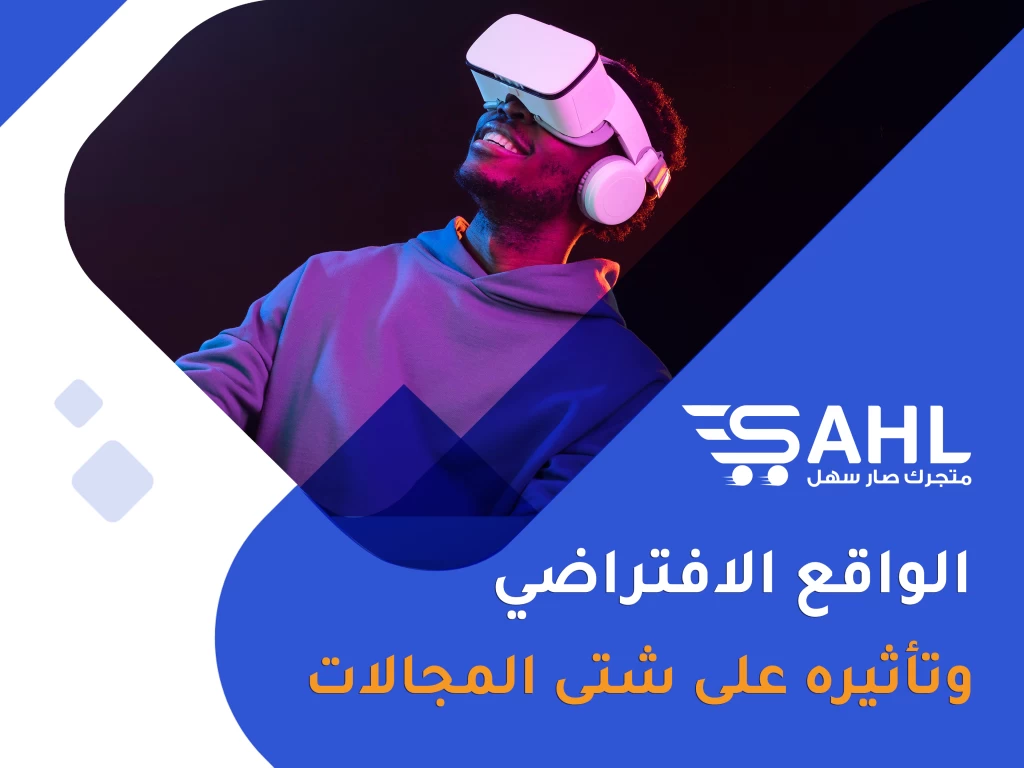Free support 24/7
Free support 24/7

Digital technologies and modern technology are among the most important factors that embody a rapid development in a variety of fields, including the field of visual experience through virtual reality and augmented reality technologies. These technologies have undergone radical transformations over the years, greatly affecting the way humans interact with the world around them. Virtual Reality and Augmented Reality are two multidimensional technologies that represent extraordinary progress in expanding and improving the boundaries of the visual experience.
Virtual Reality (VR)
The technology behind virtual reality is one of the most important drivers of development in the field of visual experience. Virtual reality technology aims to create completely simulated environments, where the user is immersed in a world completely separate from the real world. This is done by wearing virtual reality glasses that immerse the vision in 3D images and allow the user to interact with the environment through the movements of his head and hands using dedicated controllers.
Virtual reality technologies have evolved significantly since their first appearance, as image quality has improved and response time has been reduced, which has contributed to a greater depth of realism in the experience. The development also includes motion tracking and biosensing technologies, allowing for a more interactive and realistic experience.
Augmented reality
In contrast to virtual reality, augmented reality technology combines virtual elements with real reality. This is done through the use of devices such as smartphones or specialized eyeglasses. These devices project digital content such as 3D images or additional information on top of a real-world scene.
Augmented reality technology has introduced new and innovative experiences in a variety of fields. In the field of education, augmented reality can make lessons more interactive by showing and explaining 3D models realistically. In medicine, augmented reality can be used to improve surgeons' training by showing the internal structures of the body during surgical procedures.
future influences and challenges
Many areas have been affected by the development of virtual reality and augmented reality technologies. In the field of games, experiences are becoming more exciting and realistic, which has contributed to the growth of the industry significantly. In the fields of travel and tourism, individuals can explore different tourist destinations before visiting them through augmented reality.
However, these technologies are not without challenges. These include health and safety issues, as the use of virtual reality can cause dizziness or side effects on visual health.
In addition to the positive effects, there are challenges facing virtual and augmented reality technologies. Among these challenges:
Cost and technical capabilities: The advanced equipment and equipment in the field of visual experience was an exorbitant cost in the beginning. Despite the advancement of technology and the availability of devices at lower prices, the investment costs in these technologies are still a pivotal factor in broadband access.
User Experience and Convenience: Some people may have difficulty adjusting to the virtual reality experience due to the varying tolerance of individuals to benefiting from these technologies. User comfort largely depends on the design of the devices and the quality of interaction with them.
Impact on meeting and social interaction: Intense engagement in real-world experiences may lead to isolation for some individuals from the real world and social interaction. This raises questions about the impact of this type of technology on social relations and culture.
Privacy and Security: The uses of new visual technologies pose privacy and security issues. With the collection of personal data and information from users, it must be ensured that this data is protected and that unwanted use is prevented.
Industrial and educational applications: These technologies are considered promising in areas such as education, training and medicine. However, more specialized and effective applications and tools for use in these areas still need to be developed.
future and expected developments
Virtual reality and augmented reality technologies are expected to continue to develop at a rapid pace. Devices may see amazing improvements in picture quality, and more complex and realistic interactive experiences will be presented. New technologies will appear that allow more diverse interaction with virtual and augmented environments.
As these technologies evolve, a wide range of fields can benefit from an improved visual experience, be it business and entertainment or education and health. This development will contribute to changing the way we interact with the environment and information around us.
Development of industrial and educational applications
Virtual and augmented reality technologies go beyond their applications in the areas of entertainment, as they play an important role in industrial and educational applications. In industry, visual technologies can be used to improve product design and development, as engineers and designers can work within a virtual environment to test prototypes and assemblies before they are actually manufactured. This can reduce costs and speed up production.
In education, visual technologies provide opportunities to improve and extend learning processes. Students can explore 3D learning materials realistically, by experiencing simulated events and phenomena. These technologies can stimulate curiosity and make difficult concepts easier to understand.
Entertainment and games: exceptional and interactive experiences
The gaming industry is one of the biggest beneficiaries of virtual reality and augmented reality technologies. These technologies enable players to immerse themselves in stunning 3D worlds, where they can interact with the environment and characters in new and exciting ways. Virtual reality games provide more realistic experiences, where users can feel the complete realism of the environments around them and move around in them.
Medicine and Healthcare: Enhanced Training and Diagnostics
In medicine and healthcare, optical technologies present opportunities
enormous potential for improving training and diagnostics. Surgeons can rehearse complex surgical procedures using virtual reality, where they can practice steps and improve their skills before entering the actual surgical room. Physicians can also use visual technologies to clarify diagnoses for patients using 3D models of organs and tissues.
Impact on art and creativity
Virtual reality and augmented reality technologies were not limited to scientific and commercial fields only, but also extended their influence to the field of art and creativity. Artists use these techniques to create innovative and stunning works of art, where audiences can immerse themselves in interactive worlds full of amazing colors and shapes.
future and expected challenges
With the advancement of technology and continuous research, virtual reality and augmented reality technologies are likely to see greater improvements in performance and quality. New devices may emerge that merge virtual and augmented reality in innovative ways, providing diverse and exciting interactive experiences.
However, potential challenges in the future must be considered. These include balancing public and private applications, and addressing privacy and security issues. Furthermore, there should be an emphasis on directing these technologies towards realizing social and environmental benefits in a sustainable and responsible manner.
Utilize technologies sustainably and responsibly
There is no doubt that the future of the evolution of the visual experience is exciting and full of possibilities. These technologies can change the way we interact with the world and improve our lives in general. However, we must remember that they bear a great responsibility towards society and the individual.
We must have a sustainable approach towards applying technologies in a way that achieves a balance between progress and preserving values and ethics. We must work together to develop rules and a framework based on the principles of transparency and protection of personal data, and to ensure that technology integrates seamlessly and securely into people's lives.
Entertainment and information influences
Virtual reality and augmented reality technologies are sure to have significant impacts on the entertainment and media industries. In the field of film and television, audiences can feel more involved in the action through virtual reality experience. This will allow viewers to experience movies and programs in a different and more interactive way.
On the other hand, augmented reality technologies can improve the advertising and marketing experience. Companies can use augmented reality to display their products in an innovative and attractive way, where customers can view and test products in 3D before purchasing.
Culture and Heritage: Preservation and Restoration
Virtual and augmented reality technologies are a powerful tool in preserving heritage and promoting culture. Museums and historical sites can use these technologies to revive the past and realistically recreate historical events. People can walk around old palaces or historical sites as if they lived in that period.
Distance Learning and Training: The Educational Revolution
One of the main areas that benefit from virtual reality and augmented reality technologies is education. These technologies represent a quantum leap in education and training methods. Students can immerse themselves in realistic learning environments, such as experiencing a journey into space or a visit to different cultural places, without having to physically leave.
It is worth noting that these technologies may contribute to expanding the scope of education and training for individuals in remote or disadvantaged areas, as they can access learning resources through visual experiences.
economy and investment opportunities
With the increasing demand for virtual reality and augmented reality technologies, new investment opportunities will be provided in this field. New companies will be created to develop and manufacture hardware and software related to these technologies. The increased application of these technologies will also require the training of specialists and professionals in a variety of fields, leading to the creation of new job opportunities.
Ethical and social challenges
Virtual and augmented reality technologies pose ethical and social challenges that require us to think deeply and make informed decisions. Among these challenges:
Isolation of the individual: Deep immersion in real-world experiences can detach individuals from real reality and social interaction. Users must find a balance between using these technologies and maintaining their connection to the real world.
Impact on mental health: Intense virtual reality experiences may affect the mental health of individuals, such as dizziness and nausea disorders. Companies and developers must take these aspects into consideration when designing and developing their applications.
Ethical Challenges in Content: Consider the ethical challenges that may arise from creating VR and AR content. Inappropriate or harmful content can appear, and this requires a strict ethical framework to guide such creations.
Impact on the environment and sustainability
Virtual reality and augmented reality technologies require significant energy and technology resources. Increased use may lead to an increase in demand for electricity and resources, which increases pressure on the environment. Developers and companies should direct their efforts towards developing more sustainable technologies and reducing environmental impact.
Legal issues and intellectual property rights
Legal issues may arise over the ownership of 3D content and software in the world of virtual and augmented reality. It is necessary to put in place legal legislation and policies that regulate intellectual property rights and define issues related to content and digital assets.
Diversity and inclusion
When developing virtual and augmented reality technologies, we must strive for diversity and inclusivity. The design should be accessible and appropriate for different age groups and cultures, and ensure a satisfactory experience for all without discrimination.
Reliance on technology
The increasing reliance on virtual reality and augmented reality technologies may lead to a decrease in
The ability to interact and communicate in the real world. It is important that we maintain a balance between benefiting from technology and preserving traditional human ties.
Integration with AI and mega analytics
As virtual reality and augmented reality technologies advance, we may see deeper integration with big analytics and artificial intelligence. This can improve the experience by offering personalized content and experiences according to users' interests.
Integration with other developments
Virtual and augmented reality technologies can be integrated with other developments such as artificial intelligence, the Internet of Things, and biocomputing technologies. This integration could open the door to new and amazing experiences, such as augmented reality that senses our interactions and reacts to them automatically.
Sustainability and the environment
As reliance on technology increases, we must consider its effects on the environment. Manufacturing and operating virtual reality and augmented reality devices consume large resources of energy and materials. It is necessary to develop more efficient technologies in terms of energy use and waste reduction.
Advanced medical and scientific uses
An interesting area is the use of virtual and augmented reality technologies in scientific research and medicine. It can be used for big data analysis and visualization of 3D molecular structures, which contributes to the advancement of research and scientific development.
Effects on education and training
With virtual and augmented reality technologies, education and training methods can be transformed. Students and learners can live completely realistic learning experiences without the need to be physically present on site. It can be used in science education, geography, and even medical and engineering training, where students can experiment with surgical procedures or accurately assemble technical components.
Entertainment and electronic games
We cannot forget the role of virtual reality and augmented reality technologies in the field of electronic games and the entertainment industry. It has become commonplace to see games that exploit these technologies to provide exciting and realistic experiences for players, which increases the popularity of these games and improves the interaction of players with virtual worlds.
Skills development and vocational training
Augmented reality technologies may offer opportunities for vocational training and skills development. Workers can experience a realistic simulation of daily tasks in a safe and virtual environment. For example, doctors can practice complex medical procedures, and engineers can test their designs before implementing them in the real world.
Change in working methods and cooperation
Augmented reality technologies can transform the way we work and collaborate. Companies can use augmented reality to coordinate work between geographically dispersed teams, where people can communicate and interact as if they were in the same place.
Develop art and creativity
Virtual and augmented reality technologies provide a new platform for artists and creators to express their ideas and creativity. Artists can create 3D artwork that interacts with viewers, and designers can create new visual experiences that combine reality and imagination.
Impact on the economy and trade
Virtual and augmented reality technologies can have a significant impact on the economy and trade. New investment opportunities may arise in the areas of software development, hardware manufacturing, and services related to these technologies.
conclusion
It is clear that the development of virtual reality and augmented reality technologies will greatly affect various aspects of our lives. Their correct and responsible use will improve our everyday experience and develop a wide range of industries and sectors. But we must be aware of the potential challenges and consequences and take action to deal with them effectively.

Flash sales are not just a temporary marketing tool. They are a smart tool to quickly drive sales and increase engagement in your store

تعرف على الطريقة الذكية اللي تخليك تستفيد من تجارب عملاءك السابقين في تسويق منتجاتك الجديدة وزيادة المبيعات
You can create your store easily